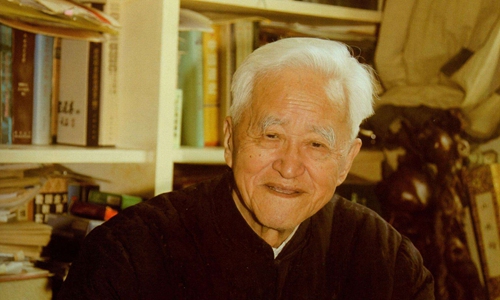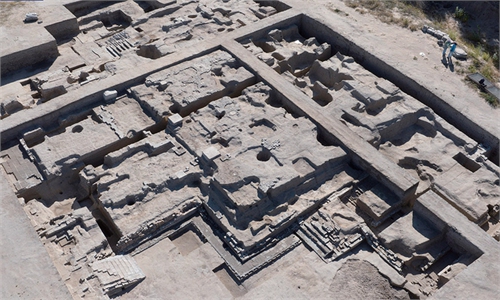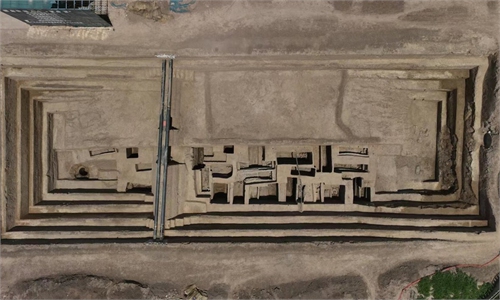Over 300 ancient tombs found in East China shed light on relationship between flooding and burial sites
Over 300 ancient tombs from the Western Han Dynasty (206BC-AD25) to the Qing Dynasty (1644-1911) containing over 1,300 artifacts have been unearthed from two sites in Jinan, East China's Shandong Province, shedding light on the relationship between flooding and burial sites, as well as burial practices in ancient times, according to a Tuesday report by the local newspaper Jinan Daily.
The first excavation in the Zhangqiu district began in early July and concluded in mid-January. A total of 168 tombs have been unearthed, with the majority dating back to the Qing Dynasty, followed by the Han Dynasty, and a smaller number from the Tang (618-907) to Ming (1368-1644) dynasties. The tomb structures mainly include pit caves, brick tombs and stone tombs.
All the tombs excavated at the site are small-scale, and the architectural styles and burial items found are those commonly seen from tombs discovered in the Jinan area.
This excavation has provided new materials for the study of burial customs, and social and historical research into various periods.
During the excavation, multiple clusters of tombs, with each group showing consistent structure and similar orientation, were found. These are believed to be family burial plots from different historical periods.
In addition, over 1,000 artifacts have been unearthed from the site, including pottery, porcelain, ceramic, and bronze items, as well as iron swords.
Meanwhile, another archaeological excavation was conducted in Qingning village in the Jiyang district from May to January. A total of 167 tombs spanning the Song (960-1127) to Qing dynasties were cleared, with the majority being from the Ming and Qing periods. Some of the tombs have brick carvings and colorful paintings.
Most of the tombs have been damaged to varying degrees. The burials include earth pit tombs, boat-shaped tombs, and brick-carved and mural-painted tombs, providing new materials for the study of the evolution of tomb designs in the area.
Among them, the discovery of boat-shaped tombs from the Song to Ming dynasties provides new insight into the evolution and development of burial practices.
Archaeologists noted that Qingning village, situated near the Yellow River, was heavily affected by flooding. This excavation provided valuable evidence for studying the hydrology and the relationship between flooding and burial sites in ancient times, contributing to understanding the construction of tombs and subsequent sedimentary sequences, according to the report.
The first excavation in the Zhangqiu district began in early July and concluded in mid-January. A total of 168 tombs have been unearthed, with the majority dating back to the Qing Dynasty, followed by the Han Dynasty, and a smaller number from the Tang (618-907) to Ming (1368-1644) dynasties. The tomb structures mainly include pit caves, brick tombs and stone tombs.
All the tombs excavated at the site are small-scale, and the architectural styles and burial items found are those commonly seen from tombs discovered in the Jinan area.
This excavation has provided new materials for the study of burial customs, and social and historical research into various periods.
During the excavation, multiple clusters of tombs, with each group showing consistent structure and similar orientation, were found. These are believed to be family burial plots from different historical periods.
In addition, over 1,000 artifacts have been unearthed from the site, including pottery, porcelain, ceramic, and bronze items, as well as iron swords.
Meanwhile, another archaeological excavation was conducted in Qingning village in the Jiyang district from May to January. A total of 167 tombs spanning the Song (960-1127) to Qing dynasties were cleared, with the majority being from the Ming and Qing periods. Some of the tombs have brick carvings and colorful paintings.
Most of the tombs have been damaged to varying degrees. The burials include earth pit tombs, boat-shaped tombs, and brick-carved and mural-painted tombs, providing new materials for the study of the evolution of tomb designs in the area.
Among them, the discovery of boat-shaped tombs from the Song to Ming dynasties provides new insight into the evolution and development of burial practices.
Archaeologists noted that Qingning village, situated near the Yellow River, was heavily affected by flooding. This excavation provided valuable evidence for studying the hydrology and the relationship between flooding and burial sites in ancient times, contributing to understanding the construction of tombs and subsequent sedimentary sequences, according to the report.



